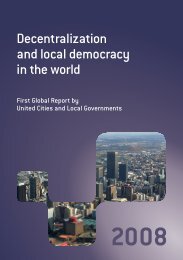Making Cities Resilient Report 2012
Making Cities Resilient Report 2012
Making Cities Resilient Report 2012
You also want an ePaper? Increase the reach of your titles
YUMPU automatically turns print PDFs into web optimized ePapers that Google loves.
CHAPTER 5 | LOOKING FORWARD: WHAT ARE SOME POSSIBLE APPROACHES TO MEASURING RESILIENCE IN CITIES<br />
What cities interviewed indicate as components of successful<br />
risk reduction in their city<br />
Essential 10: Reconstruction<br />
Essential 9: Preparedness<br />
Essential 8: Environment<br />
Essential 7:<br />
Training<br />
and Awareness<br />
Essential 1: Institutional and<br />
Adminstrative Framework<br />
Essential 6:<br />
Planning<br />
Essential 5:<br />
Schools and Hospitals<br />
Essential 4:<br />
Infrastructure<br />
Essential 2:<br />
Financing<br />
Essential 3:<br />
Risk Assessment<br />
Second, projects that address specific risks, including improving infrastructure to control floods retrofitting<br />
buildings, or construction of safe schools, were cited as the second most important component of<br />
resilience building, based on the specific risks facing the respondents’ cities.<br />
Third, the risk reduction priorities of local governments are context-specific, pointing to the fact that<br />
indicators must be locally developed, based on the city’s risks and its current governance systems. A city<br />
in an earthquake-prone area with many buildings that are not earthquake-resilient would see retrofitting<br />
and replacement of this building stock as a chief indicator of their resilience. Another city that has<br />
recently experienced a large-scale disaster would prioritize risk-sensitive urban planning and the initiation<br />
of activities to address risk as a good indicator of resilience. For a territory (region) plagued by regular<br />
flooding, cooperation among regional stakeholders of a river-basin may be an important indicator. These<br />
findings reveal that existing global indicators as part of a planning process are just a starting point and<br />
that the process itself of developing local and context-specific indicators is an equally important step<br />
toward resilience.<br />
<strong>Making</strong> <strong>Cities</strong> <strong>Resilient</strong> <strong>Report</strong> <strong>2012</strong> | 69

















